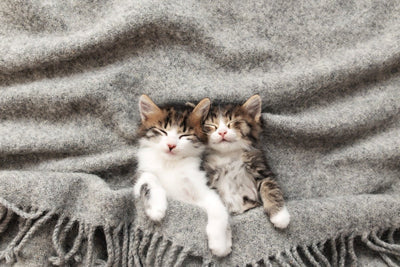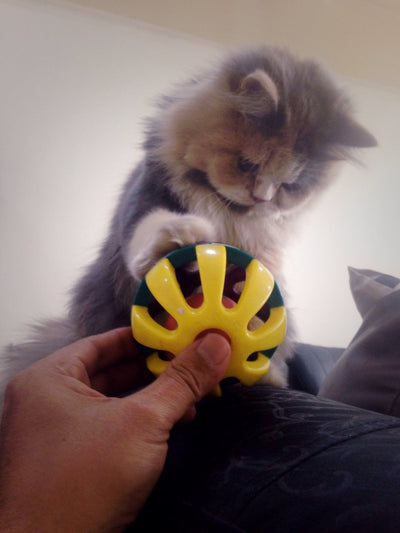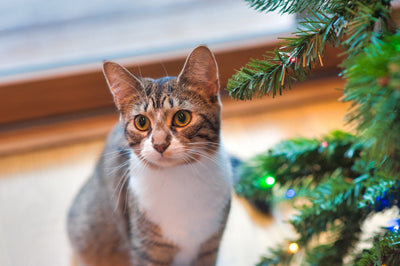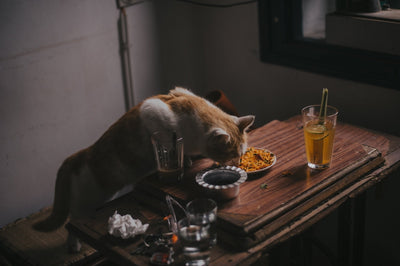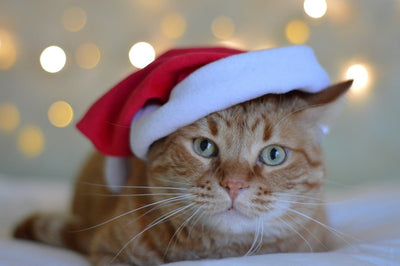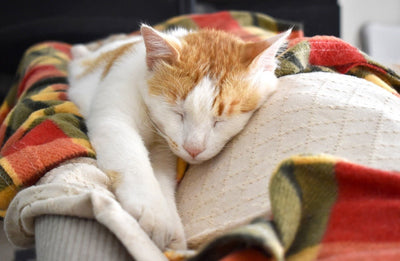 Spend AED 100 more for Free Shipping!
Spend AED 100 more for Free Shipping!
The Best Cat Litter : A Comprehensive Guide
26Jan

Discover the purr-fect litter for your feline friend: A comprehensive guide to clumping, non-clumping, natural and specialty cat litters
Cats are beloved pets, but as any cat owner knows, litter can be a significant source of stress and frustration. With so many different types of litter on the market, it can be challenging to know which is best for your feline friend. This article will look at the different kinds of cat litter available and help you decide which is the best for your cat.
Clumping Cat Litter
Clumping litter is one of the market's most popular types of cat litter. They are made from clay or other absorbent materials that form clumps when they come in contact with moisture. These clumps can be quickly scooped out, leaving the rest of the litter clean and fresh. Clumping litter is effective at controlling odors and is easy to maintain. However, they can be more expensive than non-clumping litter and are not biodegradable.

Popular Clumping Litter Brands are:
Pros |
Cons |
Easier to scoop and dispose of waste |
More expensive than conventional clay litter |
Less odor control is needed as clumps can be removed and disposed of |
Dustier than other types of litter |
Less litter is needed as it lasts longer than traditional clay litter |
Some cats may be allergic to the ingredients in clumping litter |
Less tracking of litter around the house as it is less likely to stick to the cat's paws |
Inhaling the dust can harm humans and cats, especially those with respiratory issues. |
It is essential to remember that clumping litter is not biodegradable and should not be flushed down the toilet or disposed of in the regular garbage. Instead, it should be disposed of in a sealed bag in the trash. Also, it is essential to change the litter frequently to avoid the build-up of bacteria and odors.
Non-Clumping Litter
Non-clumping litters are a more traditional type of cat litter. They are made from clay, clay-based products, or other natural materials. They do not form clumps when they come in contact with moisture, so the entire litter needs to be changed when it becomes soiled. Non-clumping litters are generally less expensive than clumping litters, but they are less effective at controlling odors and can be more challenging to maintain.

Popular Non-Clumping Litter Brands are:
Pros |
Cons |
Less expensive than clumping litter |
Not as easy to scoop and dispose of waste |
Less dusty |
More odor management may be needed |
Fewer cats may be allergic to the ingredients |
More litter may be needed |
Less likely to be harmful to humans and cats with respiratory issues |
More tracking around the house may occur |
It's important to remember that every cat is different, so it's essential to observe your cat's behavior and preferences when choosing a litter. Additionally, keep in mind that some non-clumping litter, such as clay litter, can harm the environment when disposed of properly. Therefore, it's essential to read the instructions on the package and follow the disposal instructions.
Natural Litter
Natural litter is made from natural materials, such as corn, wheat, or pine. These litters are biodegradable and more environmentally friendly than traditional litter. Natural litter can effectively control odors and are generally low in dust. However, they can be more expensive than conventional litter, and some cats may be allergic to the scents used in the natural litter.

Popular natural Litter Brands are:
Pros |
Cons |
Made from natural, renewable resources (e.g., corn, wheat, pine) |
More expensive than traditional clay litter |
Biodegradable and compostable |
Some litters may not clump as well as clay-based litters |
Low dust and minimal tracking |
Some cats may be allergic to the ingredients in a natural litter |
Less likely to cause respiratory issues for cats and humans |
Some litters may not have the same odor control as clay-based litters |
It's essential to read the instructions on the package and follow the disposal instructions carefully, as some natural litter can't be flushed down the toilet; it must be disposed of in a composting facility.
Specialty Litters
Specialty litters are designed for specific needs, such as litters for cats with respiratory issues or litters that are especially good at controlling odors. These litters can be made from various materials, such as silica gel, and can be more expensive than traditional ones. However, they can be an excellent option for cats with specific needs.
Popular Speciality Litter Brands are:
Pros |
Cons |
It may be specifically formulated for specific needs (e.g., odor control, clumping ability, low dust) |
More expensive than traditional clay litters |
It may be made from more eco-friendly materials (e.g., recycled paper, coconut shells) |
Some cats may be allergic to the ingredients in specialty litter |
It may be more effective at controlling odors or clumping than traditional litter. |
Some specialty litters may not be as widely available as traditional litter |
Some may not be flushable or biodegradable and should be disposed of carefully |
Pros and Cons of Different Types of Cat Litters
Type of Litter |
Pros |
Cons |
Clumping Litter |
Easy to maintain, effective at controlling odors |
More expensive, not biodegradable |
Non-Clumping Litter |
Less expensive |
Difficult to maintain, not as effective at controlling odors |
Natural Litter |
Biodegradable, low dust, effective at controlling odors |
More expensive, some cats may be allergic to scents |
Specialty Litter |
Designed for specific needs, effective at controlling odors |
More expensive |
Choosing the Best Cat Litter for Your Feline Friend
Choosing the best cat litter for your feline friend is a personal decision that will depend on your cat's needs and preferences. Clumping litters may be the best choice if you're looking for an easy-to-maintain option. Natural litter may be the best choice if you're looking for a more eco-friendly option. Specialty litters may be the best choice if you're looking for a litter with good odor control properties. Ultimately, the best cat litter for your cat will depend on your cat's individual needs and preferences.

The Purrfect Litter Box: Essential Tips for Your Cat's Comfort and Well-being
For your pet cat, you may already have selected a litter. However, we advise that you read the following guidelines to provide your cat with the greatest experience possible:
1. Placement of the Cat Litter Box
The Cat litter box should be located in a quiet and isolated area, away from high-traffic areas such as walkways and near doors. This is to ensure that your cat has a private and peaceful place to relieve itself. It is also best to place the litter box away from central areas in a room, as these areas tend to be more congested.
2. Size of the Cat Litter Box
Getting the right size of the litter box is crucial for your cat to develop good litter box habits. The litter box should be big enough for your cat to move around comfortably, with enough room to turn around without restriction. If the litter box is too small or uncomfortable, your cat may find another place to relieve itself.
3. Consistency and Amount of Cat Litter
The litter should be absorbent, with a grainy texture suitable for digging and covering. A thickness of around 3 inches is usually enough to absorb odors and keep the area fresh.
4. Choosing the Right Cat Litter
When selecting the right Cat litter, there are several factors to consider. Firstly, the litter should have a natural look, as bright and artificial-looking litter may make your cat uncomfortable. You may also choose between scented and unscented litter, which often provides better odor control. However, it is essential to note that some cats may not like the scent, which may discourage them from using the cat litter box.
5. Keeping the Litter Tray Clean
It is essential to keep the litter tray clean to maintain good hygiene for your cat and your home. Depending on how often your cat uses the litter box and the type of litter you choose, cleaning and changing the litter as frequently as possible is important.
Conclusion
In conclusion, choosing the best cat litter for your feline friend is an important decision that will depend on your cat's needs and preferences. Clumping litters are easy to maintain and effective at controlling odors, while non-clumping litters are less expensive but more difficult to maintain. Natural litters are biodegradable and effective at controlling odors, while specialty litters are designed for specific needs and can be more expensive. Weighing the pros and cons of each type of litter can help you make an informed decision about which one is the best for your cat. Ultimately, the best cat litter for your cat will depend on your cat's individual needs and preferences, and it's essential to experiment with different types to find the one that works best for you and your cat.
Frequently Asked Questions
Q: What types of cat litter are available?
A: There are several types of cat litter available, including clumping litter, non-clumping litter (such as clay and silica gel), natural litter (made from renewable resources like corn, wheat, and pine), and specialty litters (formulated for specific needs like odor control or clumping ability).
Q: What is the best type of cat litter?
A: The best type of cat litter depends on your individual needs and preferences and those of your cat. Clumping litters are famous for their ease of use and odor control, while natural litters are a more eco-friendly option. Specialty litters may be formulated for needs such as odor control or clumping ability.
Q: Are clumping litters safe for cats?
A: Clumping litters are generally safe for cats, but as with any litter, it is essential to read the instructions on the package and follow them carefully. Some cats may be allergic to the ingredients in clumping litters, and inhaling the dust can harm humans and cats, especially those with respiratory issues.
Q: How often should I change my cat's litter?
A: It is recommended to change your cat's litter at least once a week or more often if you notice a strong odor. Additionally, it is important to scoop the litter daily to remove any solid waste.
Q: Can natural cat litter be flushed down the toilet?
A: Some natural litters can be flushable or biodegradable, but not all. It is essential to read the instructions on the package and follow the disposal instructions carefully. Some natural litter can't be flushed down the toilet; they must be disposed of in a composting facility.
Q: Can I use specialty litters for kittens?
A: Specialty litters can be used for kittens, but it is essential to read the instructions on the package and follow them carefully. Some litters are formulated for adult cats and may not be suitable for kittens.
Q: What is the ideal location for a cat litter box?
A: The best location for a litter box is in a quiet and isolated place, away from high traffic areas and central spaces like the middle of a room.
Q: What size should the litter box be for my cat?
A: The size of the litter box should be appropriate for your cat's size, allowing them to turn around inside comfortably without constraint.
Q: What is the appropriate amount and consistency of cat litter?
A: The litter should be absorbent and have a grainy texture with a layer thickness of around 3 inches to absorb odors and allow digging and covering.
Q: What if my cat refuses to use the litter box?
A: If your cat refuses to use the litter box, consider the location, size, type of litter, and cleanliness of the box. Contact a veterinarian for further advice if needed.
The information provided on the blog is for educational and informational purposes only and is not intended as a substitute for professional advice from a veterinarian or other qualified professional.
Reference Source: NYTIMES

 Facebook
Facebook